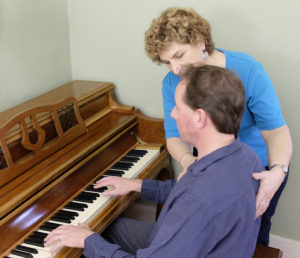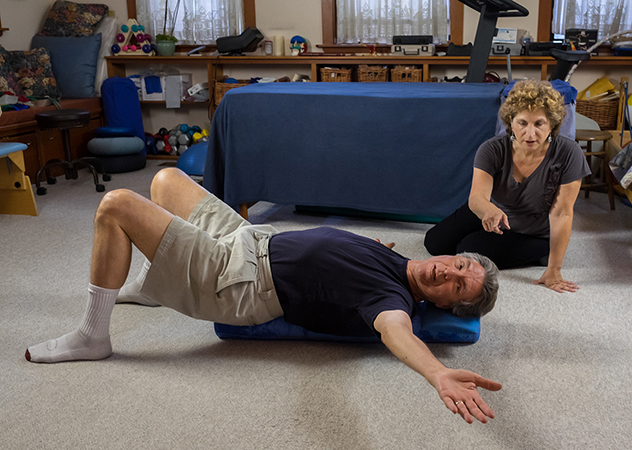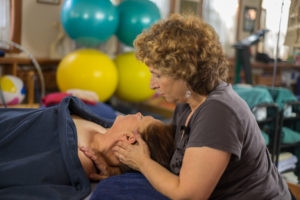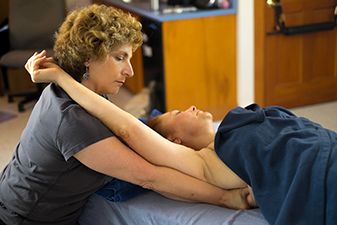Repetitive Strain Injury

When left untreated, minor pains that occur during or after a repetitive activity such as computer use, can escalate into a condition known as Repetitive Strain Injury. This syndrome involves one or more areas of pain including the neck, shoulder, arm and/or hand due to nerve compression or joint strain. It is a frequent problem among those who play an instrument or use a keyboard or mouse for many hours at a time. The causes are poor posture, poor ergonomic set- up and/or poor typing technique. |
Nerve compression in the neck
A chair that has the ability to provide multiple options of supportive neutral positioning is essential for successful computer use. When doing an activity in a seated position without back support such as playing piano, there is no substitute for learning good posture and body mechanics. A chair is as important an investment as physical therapy, if it is your environment for many hours in a week. |
Nerve compression due to tight chest muscles
|
Other Common Areas of Nerve Irritation
Nerve compression at the pronator tunnel on the palm side of the forearmThe median nerve, which feeds the thumb and next two fingers, can be compressed as it passes between two parts of the pronator muscle. This is the muscle that turns the palm facing downwards. If one doesn’t naturally have the range of motion to place the palms flat down without using excess contraction of the pronator muscle, nerve compression can occur there. One possible solution might be to use a keyboard that is split and tilts up at its midline so the hands don’t have to meet the flat surface of a standard keyboard. |
Nerve compression at the carpel tunnelThe median nerve can be squeezed at the base of the palm as it passes through a tunnel filled with the nerves and tendons that work the fingers. This causes pain, tingling and/or numbness into the thumb and forefingers. Tendonitis at the base of the thumb or the pinkie side of the wrist can be caused by not maintaining the wrist in a neutral position. The wrist may hyperextend if the angle of the keyboard is tilted up toward you rather than being flat or tilted away, or if you rest you wrists on a keyboard tray. The wrist may turn out (ulnar deviate), as you hold your hands to place all fingers on “home keys”. This means that instead of having a straight line from the middle of your forearm through the center of the hand there is an angle at the wrist. One solution to the ulnar deviation problem might be the use of a split keyboard that allows the user to angle the keyboard like a “V” with the point toward their middle. |
Double Crush Phenomenon
When one part of a nerve pathway becomes irritated due to compression, adhesions, scar tissue, or inflammation, then other parts of the nerve become more vulnerable to irritation. In other words, due to impaired transmission of signals along the pathway, the threshold of irritation is lowered for other areas along the nerve’s path. Treatment is much easier and quicker if you catch the problem before multiple areas are involved. |
These are only a few examples of diagnoses and causes I have seen in the realm of RSI. This is not meant to be a comprehensive discussion.
What Can be Done?Treatment involves neuromuscular re-education of correct body posture and exercise to stretch tight muscle groups and strengthen weak ones. Just to tell a person, “sit up straight, hold your shoulders back, and lift your head up,” is not usually helpful. People need to be trained through kinesthetic learning to change deeply ingrained movement and posture habits. This is part of what we, as Aston-Patterning Practitioners, have learned to do well. In addition, we do very specific hands-on bodywork to release adhesions/restrictions in the muscles, connective tissues, and joints. We also do ergonomic assessments of our patient’s workstations and suggest equipment including chairs, keyboards, mice, and copyholders. |

 Nerves send and receive messages from the spinal cord to the rest of the body. These nerves can become compressed where they exit the spinal canal, or as they pierce through the scalene muscles on the side of the neck. This commonly happens after a whiplash injury, especially when left untreated. These irritated nerves that supply the arms and shoulder blades can cause pain in various parts of the arm depending on which part of the nerve bundle is involved. This also can be caused by sitting with a collapsed trunk posture that does not provide an adequate base of support for the weight of the head. The head is displaced forward causing neck muscles to contract forcefully to support the head. Chronic excessive muscle contraction leads to neck pain and pinched nerves. Sometimes the nerve tension resulting from an injury or poor posture can lead to excess tension in the “thoracic outlet” as well and can also create pain and or numbness in the arm or hand.
Nerves send and receive messages from the spinal cord to the rest of the body. These nerves can become compressed where they exit the spinal canal, or as they pierce through the scalene muscles on the side of the neck. This commonly happens after a whiplash injury, especially when left untreated. These irritated nerves that supply the arms and shoulder blades can cause pain in various parts of the arm depending on which part of the nerve bundle is involved. This also can be caused by sitting with a collapsed trunk posture that does not provide an adequate base of support for the weight of the head. The head is displaced forward causing neck muscles to contract forcefully to support the head. Chronic excessive muscle contraction leads to neck pain and pinched nerves. Sometimes the nerve tension resulting from an injury or poor posture can lead to excess tension in the “thoracic outlet” as well and can also create pain and or numbness in the arm or hand. As the bundle of nerves from the neck continue towards the arm, they pass under the collarbone and under the pectoralis minor muscle in the chest. If this muscle is short and contracted, it can squeeze the nerve bundle causing pain, tingling, numbness and/or coldness most commonly to the pinkie side of the hand and forearm. One cause of this is hand placement on a standard keyboard at the body’s midline. For a broad chested person or a large breasted woman, chronic excessive chest muscle contraction can be required just to maintain hand placement at midline. One ergonomic piece of the solution might be to purchase a split keyboard so that the hands are not required to stay at midline.
As the bundle of nerves from the neck continue towards the arm, they pass under the collarbone and under the pectoralis minor muscle in the chest. If this muscle is short and contracted, it can squeeze the nerve bundle causing pain, tingling, numbness and/or coldness most commonly to the pinkie side of the hand and forearm. One cause of this is hand placement on a standard keyboard at the body’s midline. For a broad chested person or a large breasted woman, chronic excessive chest muscle contraction can be required just to maintain hand placement at midline. One ergonomic piece of the solution might be to purchase a split keyboard so that the hands are not required to stay at midline.
